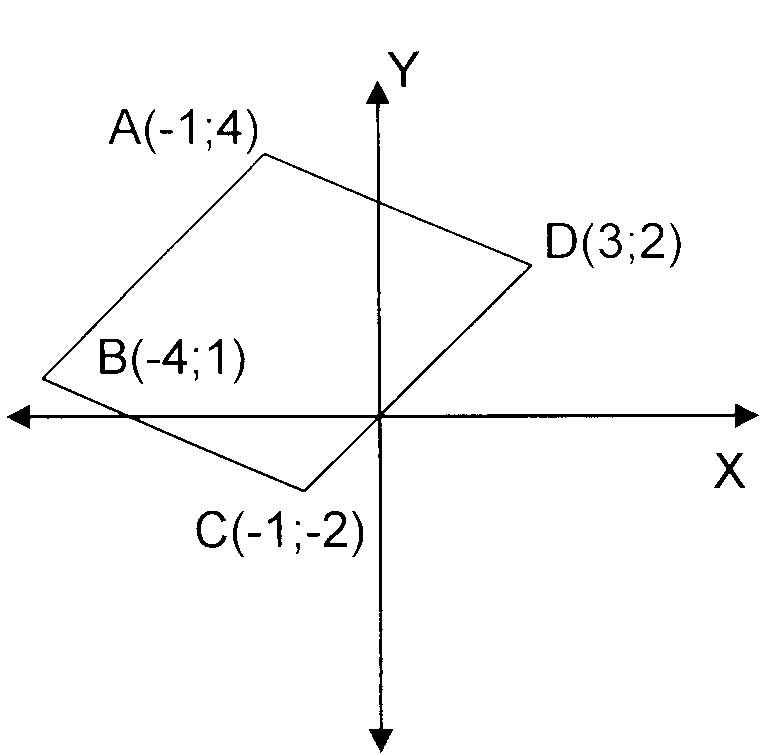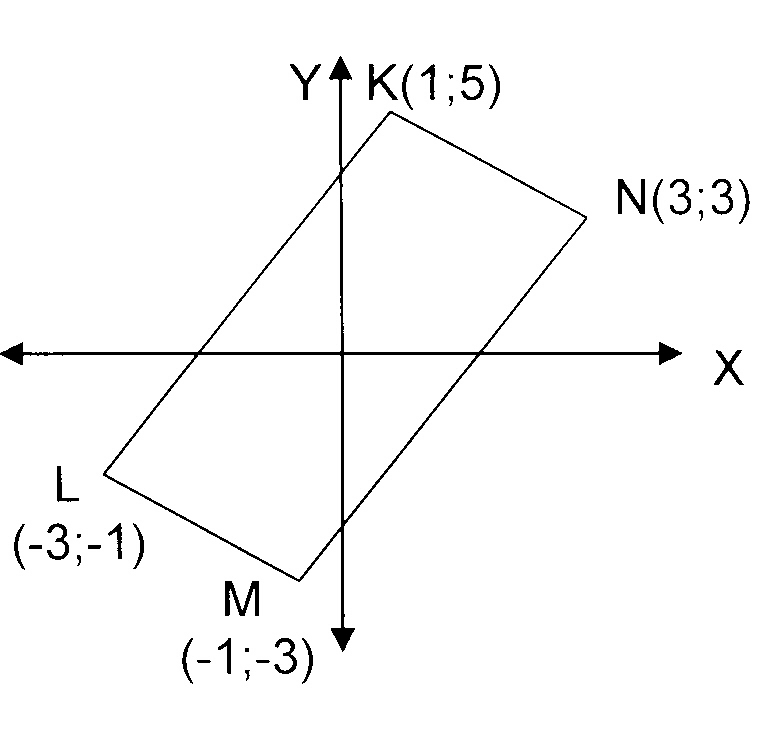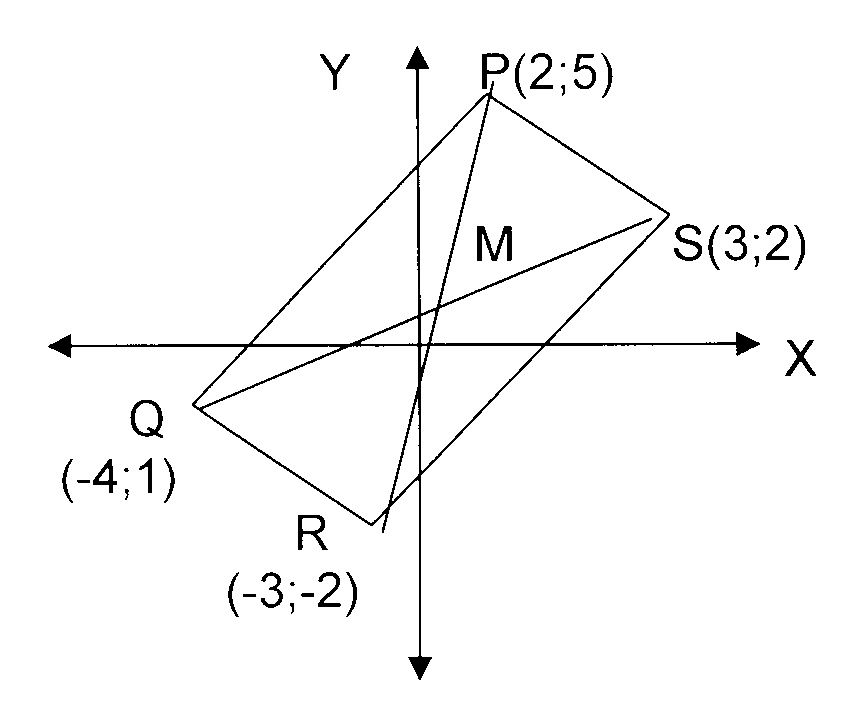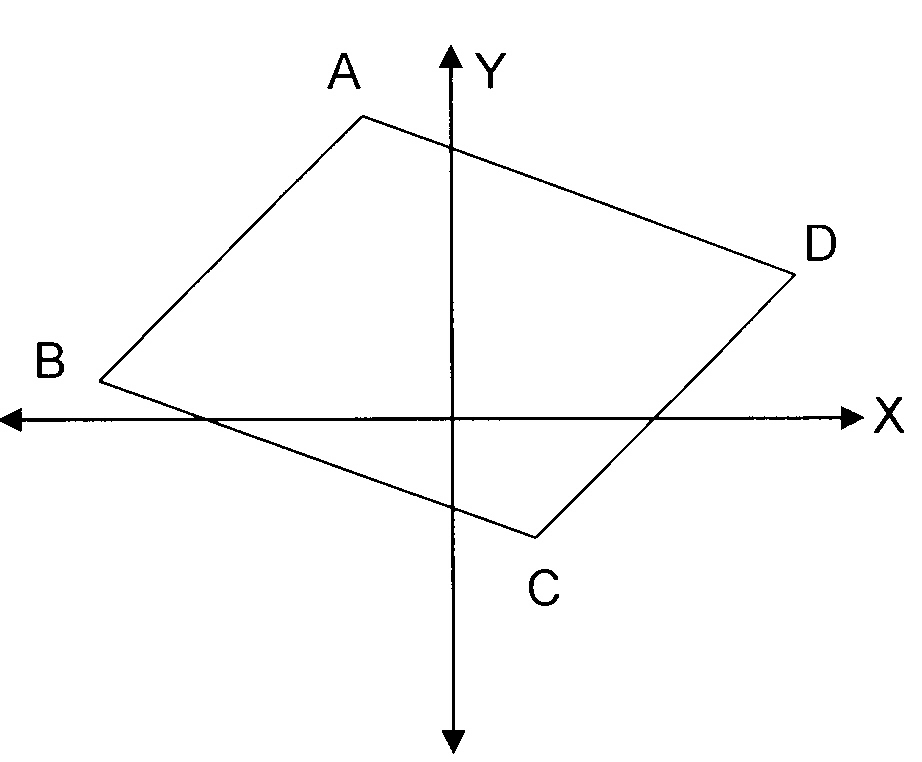WISKUNDE
GRAAD 10
NOG OEFENINGE
Toepassings.To
GRAAD 10
NOG OEFENINGE
Toepassings.To
MATHEMATICS
GRADE 10
MORE EXERCISES
Applications.
GRADE 10
MORE EXERCISES
Applications.
Gegee die punte A(−5 ; 5), B(1 ; −1) en C(3 ; 7).
1.1 Bereken AB se lengte. Ant. / Ans. 1.1
1.2 Bepaal die koördinate van D, die
middelpunt van AB. Ant. / Ans. 1.2
1.3 Is CD loodreg op AB? Ant. / Ans. 1.3
1.4 Bereken AC se lengte. Ant. / Ans. 1.4
1.5 Is ΔABC 'n gelykbenige driehoek?
Gee 'n rede. Ant. / Ans. 1.5
1.1 Bereken AB se lengte. Ant. / Ans. 1.1
1.2 Bepaal die koördinate van D, die
middelpunt van AB. Ant. / Ans. 1.2
1.3 Is CD loodreg op AB? Ant. / Ans. 1.3
1.4 Bereken AC se lengte. Ant. / Ans. 1.4
1.5 Is ΔABC 'n gelykbenige driehoek?
Gee 'n rede. Ant. / Ans. 1.5
Given the points A(−5 ; 5), B(1 ; −1) and C(3 ; 7).
1.1 Calculate the length of AB. Ant. / Ans. 1.1
1.2 Find the coordinates of D, the
midpoint of AB. Ant. / Ans. 1.2
1.3 Is CD perpendicular to AB? Ant. / Ans. 1.3
1.4 Calculate the length of AC. Ant. / Ans. 1.4
1.5 Is ΔABC an isosceles triangle?
Give a reason. Ant. / Ans. 1.5
1.1 Calculate the length of AB. Ant. / Ans. 1.1
1.2 Find the coordinates of D, the
midpoint of AB. Ant. / Ans. 1.2
1.3 Is CD perpendicular to AB? Ant. / Ans. 1.3
1.4 Calculate the length of AC. Ant. / Ans. 1.4
1.5 Is ΔABC an isosceles triangle?
Give a reason. Ant. / Ans. 1.5
A(−3 ; 5), B(−7 ; −2) en C(1 ; −2) is die
hoekpunte van ΔABC.
2.1 Bereken die volgende :
2.1.1 die gradiënt van BC. Ant. / Ans. 2.1.1
2.1.2 die lengte van AB. Ant. / Ans. 2.1.2
2.1.3 die koördinate van M, die
middelpunt van BC. Ant. / Ans. 2.1.3
2.2 Is AM die middelloodlyn van BC?
Gee 'n rede. Ant. / Ans. 2.2
2.3 Is ∠ABC = ∠ACB? Gee 'n rede. Ant. / Ans. 2.3
hoekpunte van ΔABC.
2.1 Bereken die volgende :
2.1.1 die gradiënt van BC. Ant. / Ans. 2.1.1
2.1.2 die lengte van AB. Ant. / Ans. 2.1.2
2.1.3 die koördinate van M, die
middelpunt van BC. Ant. / Ans. 2.1.3
2.2 Is AM die middelloodlyn van BC?
Gee 'n rede. Ant. / Ans. 2.2
2.3 Is ∠ABC = ∠ACB? Gee 'n rede. Ant. / Ans. 2.3
A(−3 ; 5), B(−7 ; −2) and C(1 ; −2) are the
vertices of ΔABC.
2.1 Calculate the following :
2.1.1 the gradient of BC. Ant. / Ans. 2.1.1
2.1.2 the length of AB. Ant. / Ans. 2.1.2
2.1.3 the coordinates of M the
midpoint of BC. Ant. / Ans. 2.1.3
2.2 Is AM the perpendicular bisector
of BC? Give a reason. Ant. / Ans. 2.2
2.3 Is ∠ABC = ∠ACB? Give a reason. Ant. / Ans. 2.3
vertices of ΔABC.
2.1 Calculate the following :
2.1.1 the gradient of BC. Ant. / Ans. 2.1.1
2.1.2 the length of AB. Ant. / Ans. 2.1.2
2.1.3 the coordinates of M the
midpoint of BC. Ant. / Ans. 2.1.3
2.2 Is AM the perpendicular bisector
of BC? Give a reason. Ant. / Ans. 2.2
2.3 Is ∠ABC = ∠ACB? Give a reason. Ant. / Ans. 2.3
P(−6 ; 1), Q(2 ; −7) en R(8 ; −1) is die hoekpunte
van ΔPQR.
3.1 Bereken die koördinate van S, die
middelpunt van PQ. Ant. / Ans. 3.1
3.2 Bepaal die vergelyking van die
swaartelyn/mediaan van R na PQ. Ant. / Ans. 3.2
3.3 Bereken die gradiënt van RQ. Ant. / Ans. 3.3
3.4 Watter soort driehoek is ΔPQR?
Gee 'n rede. Ant. / Ans. 3.4
van ΔPQR.
3.1 Bereken die koördinate van S, die
middelpunt van PQ. Ant. / Ans. 3.1
3.2 Bepaal die vergelyking van die
swaartelyn/mediaan van R na PQ. Ant. / Ans. 3.2
3.3 Bereken die gradiënt van RQ. Ant. / Ans. 3.3
3.4 Watter soort driehoek is ΔPQR?
Gee 'n rede. Ant. / Ans. 3.4
P(−6 ; 1), Q(2 ; −7) and R(8 ; −1) are the vertices
of ΔPQR.
3.1 Calculate the coordinates of S, the
midpoint of PQ. Ant. / Ans. 3.1
3.2 Find the equation of the median from
R to PQ. Ant. / Ans. 3.2
3.3 Calculate the gradient of RQ. Ant. / Ans. 3.3
3.4 What kind of triangle is ΔPQR?
Give a reason. Ant. / Ans. 3.4
of ΔPQR.
3.1 Calculate the coordinates of S, the
midpoint of PQ. Ant. / Ans. 3.1
3.2 Find the equation of the median from
R to PQ. Ant. / Ans. 3.2
3.3 Calculate the gradient of RQ. Ant. / Ans. 3.3
3.4 What kind of triangle is ΔPQR?
Give a reason. Ant. / Ans. 3.4
K(2 ; 9), L(−5 ; −5) en M(−13 ; −1) is die hoekpunte
van ΔKLM.
Toon dat ΔKLM 'n reghoekige driehoek is.
van ΔKLM.
Toon dat ΔKLM 'n reghoekige driehoek is.
K(2 ; 9), L(−5 ; −5) and M(−13 ; −1) are the vertices
of ΔKLM.
Show that ΔKLM is a right-angled triangle.
of ΔKLM.
Show that ΔKLM is a right-angled triangle.
D(5 ; 9), E(−3 ; 5) en F(−1 ; 1) is die hoekpunte
van ΔDEF.
Toon dat ∠DEF = 90°.
van ΔDEF.
Toon dat ∠DEF = 90°.
D(5 ; 9), E(−3 ; 5) and F(−1 ; 1) are the vertices
of ΔDEF.
Show that ∠DEF = 90°.
of ΔDEF.
Show that ∠DEF = 90°.
A(−6 ; 7), B(1 ; −3) enC(−9 ; −10) is die hoekpunte
van ΔABC.
Toon dat ΔABC 'n gelykbenige driehoek is.
van ΔABC.
Toon dat ΔABC 'n gelykbenige driehoek is.
A(−6 ; 7), B(1 ; −3) enC(−9 ; −10) are the vertices
of ΔABC.
Show that ΔABC is an isosceles triangle.
of ΔABC.
Show that ΔABC is an isosceles triangle.
P(−3 ; −2), Q(−7 ; 7) en R(2 ; 3) is die hoekpunte
van ΔPQR.
Toon dat ∠QPR = ∠PRQ.
van ΔPQR.
Toon dat ∠QPR = ∠PRQ.
P(−3 ; −2), Q(−7 ; 7) and R(2 ; 3) are the vertices
of ΔPQR.
Show that ∠QPR = ∠PRQ.
of ΔPQR.
Show that ∠QPR = ∠PRQ.
P(−4 ; 1), Q(4 ; −1) en R(5 ; −8) is die hoekpunte
van ΔPQR en S is die punt (1 ; −4).
en S is die punt (1 ; −4).
8.1 Bereken die
8.1.1 koördinate van T, die middelpunt
van PQ. Ant. / Ans. 8.1.1
8.1.2 vergelyking van die swaartelyn
van R na PQ. Ant. / Ans. 8.1.2
8.1.3 gradiënt van PR. Ant. / Ans. 8.1.3
8.2 Toon aan dat QS ⊥ PR. Ant. / Ans. 8.2
8.3 Bereken die oppervlakte
van ΔPQR. Ant. / Ans. 8.3
van ΔPQR en S is die punt (1 ; −4).
en S is die punt (1 ; −4).
8.1 Bereken die
8.1.1 koördinate van T, die middelpunt
van PQ. Ant. / Ans. 8.1.1
8.1.2 vergelyking van die swaartelyn
van R na PQ. Ant. / Ans. 8.1.2
8.1.3 gradiënt van PR. Ant. / Ans. 8.1.3
8.2 Toon aan dat QS ⊥ PR. Ant. / Ans. 8.2
8.3 Bereken die oppervlakte
van ΔPQR. Ant. / Ans. 8.3
P(−4 ; 1), Q(4 ; −1) and R(5 ; −8) are the vertices
of ΔPQR and S is the point (1 ; −4).
8.1 Calculate the
8.1.1 coordinates of T, the midpoint
of PQ. Ant. / Ans. 8.1.1
8.1.2 equation of the median from
R to PQ. Ant. / Ans. 8.1.2 ;
8.1.3 gradient of PR. Ant. / Ans. 8.1.3
8.2 Show that QS ⊥ PR. Ant. / Ans. 8.2
8.3 Calculate the area of ΔPQR. Ant. / Ans. 8.3
of ΔPQR and S is the point (1 ; −4).
8.1 Calculate the
8.1.1 coordinates of T, the midpoint
of PQ. Ant. / Ans. 8.1.1
8.1.2 equation of the median from
R to PQ. Ant. / Ans. 8.1.2 ;
8.1.3 gradient of PR. Ant. / Ans. 8.1.3
8.2 Show that QS ⊥ PR. Ant. / Ans. 8.2
8.3 Calculate the area of ΔPQR. Ant. / Ans. 8.3
A(−2 ; 3), B(−4 ; −1) en C(3 ; −2) is die hoekpunte
van ΔABC en D is die punt (3 ; −2).
9.1 Toon aan dat CD ⊥ AB. Ant. / Ans. 9.1
9.2 Bepaal die vergelyking van die mediaan
van B na AC. Ant. / Ans. 9.2
9.3 Bereken die oppervlakte
van ΔABC. Ant. / Ans. 9.3
van ΔABC en D is die punt (3 ; −2).
9.1 Toon aan dat CD ⊥ AB. Ant. / Ans. 9.1
9.2 Bepaal die vergelyking van die mediaan
van B na AC. Ant. / Ans. 9.2
9.3 Bereken die oppervlakte
van ΔABC. Ant. / Ans. 9.3
A(−2 ; 3), B(−4 ; −1) and C(3 ; −2) are the vertices
of ΔABC and D is the point (3 ; −2).
9.1 Show that CD ⊥ AB. Ant. / Ans. 9.1
9.2 Find the equation of the median
from B to AC. Ant. / Ans. 9.2
9.3 Calcualte the area of ΔABC. Ant. / Ans. 9.3
of ΔABC and D is the point (3 ; −2).
9.1 Show that CD ⊥ AB. Ant. / Ans. 9.1
9.2 Find the equation of the median
from B to AC. Ant. / Ans. 9.2
9.3 Calcualte the area of ΔABC. Ant. / Ans. 9.3
Die figuur toon vierhoek ABCD met hoekpunte
A(−1 ; 4), B(−4 ; 1), C(−1 ; −2) en D(3 ; 2).
10.1 Toon dat AB || CD. Ant. 10.1
10.2 Toon aan dat AB = CD. Ant. 10.2
10.3 Bepaal die grootte van ∠ABC. Ant. 10.3
10.4 Sê, met redes, watter soort
vierhoek ABCD is. Ant. 10.4
The figure shows quadrilateral ABCD with vertices
A(−1 ; 4), B(−4 ; 1), C(−1 ; −2) and D(3 ; 2).
10.1 Show that AB || CD. Ans. 10.1
10.2 Show that AB = CD. Ans. 10.2
10.3 Calculate the size of ∠ABC. Ans. 10.3
10.4 Say, with reasons, what kind
of quadrilateral ABCD is. Ans. 10.4
A(−1 ; 4), B(−4 ; 1), C(−1 ; −2) en D(3 ; 2).
10.1 Toon dat AB || CD. Ant. 10.1
10.2 Toon aan dat AB = CD. Ant. 10.2
10.3 Bepaal die grootte van ∠ABC. Ant. 10.3
10.4 Sê, met redes, watter soort
vierhoek ABCD is. Ant. 10.4
The figure shows quadrilateral ABCD with vertices
A(−1 ; 4), B(−4 ; 1), C(−1 ; −2) and D(3 ; 2).
10.1 Show that AB || CD. Ans. 10.1
10.2 Show that AB = CD. Ans. 10.2
10.3 Calculate the size of ∠ABC. Ans. 10.3
10.4 Say, with reasons, what kind
of quadrilateral ABCD is. Ans. 10.4

Die figuur toon vierhoek KLMN met hoekpunte
K(1 ; 5), L(−3 ; −1), M(−1 ; −3) en N(3 ; 3).
11.1 Toon dat KN || LM. Ant. 11.1
11.2 Toon aan dat KN = LM. Ant. 11.2
11.3 Is KLMN 'n reghoek?
Gee 'n rede. Ant. 11.3
The figure shows quadrilateral KLMN with vertices
K(1 ; 5), L(−3 ; −1), M(−1 ; −3) and N(3 ; 3).
11.1 Show that KN || LM. Ans. 11.1
11.2 Show that KN = LM. Ans. 11.2
11.3 Is KLMN a rectangle?
Give a reason. Ans. 11.3
K(1 ; 5), L(−3 ; −1), M(−1 ; −3) en N(3 ; 3).
11.1 Toon dat KN || LM. Ant. 11.1
11.2 Toon aan dat KN = LM. Ant. 11.2
11.3 Is KLMN 'n reghoek?
Gee 'n rede. Ant. 11.3
The figure shows quadrilateral KLMN with vertices
K(1 ; 5), L(−3 ; −1), M(−1 ; −3) and N(3 ; 3).
11.1 Show that KN || LM. Ans. 11.1
11.2 Show that KN = LM. Ans. 11.2
11.3 Is KLMN a rectangle?
Give a reason. Ans. 11.3

Die figuur toon vierhoek PQRS met hoekpunte
P(2 ; 5), Q(−4 ; 1), R(−3 ; −2) en S(3 ; 2) .
12.1 Bereken die koördinate van M, die
middelpunt van PR. Ant. / Ans. 12.1
12.2 Toon aan dat QM = MS. Ant. / Ans. 12.2
12.3 Bereken die gradiënt van QR en
van RS. Ant. / Ans. 12.3
12.4 Sê, met redes, watter soort
vierhoek PQRS is. Ant. / Ans. 12.4
P(2 ; 5), Q(−4 ; 1), R(−3 ; −2) en S(3 ; 2) .
12.1 Bereken die koördinate van M, die
middelpunt van PR. Ant. / Ans. 12.1
12.2 Toon aan dat QM = MS. Ant. / Ans. 12.2
12.3 Bereken die gradiënt van QR en
van RS. Ant. / Ans. 12.3
12.4 Sê, met redes, watter soort
vierhoek PQRS is. Ant. / Ans. 12.4

The figure shows quadrilateral PQRS with vertices
P(2 ; 5), Q(−4 ; 1), R(−3 ; −2) and S(3 ; 2)
12.1 Calculate the coordinates of M the midpoint of PR. Ant. / Ans. 12.1
12.2 Show that QM = MS. Ant. / Ans. 12.2
12.3 Calculate the gradient of QR and of RS. Ant. / Ans. 12.3
12.4 Say, giving reasons, what kind of quadrilateral PQRS is. Ant. / Ans. 12.4
12.1 Calculate the coordinates of M the midpoint of PR. Ant. / Ans. 12.1
12.2 Show that QM = MS. Ant. / Ans. 12.2
12.3 Calculate the gradient of QR and of RS. Ant. / Ans. 12.3
12.4 Say, giving reasons, what kind of quadrilateral PQRS is. Ant. / Ans. 12.4
Die figuur toon vierhoek ABCD met hoekpunte
A(−2 ; 4), B(−6 ; 1), C(3 ; −1) en D(7 ; 2).
13.1 Bereken die gradiënt van AD. Ant. / Ans. 13.1
13.2 Bereken die gradiënt van BC. Ant. / Ans. 13.2
13.3 Bereken die lengte van BC. Ant. / Ans. 13.3
13.4 Is AD = BC? Ant. / Ans. 13.4
13.5 Toon aan dat AC en BD mekaar
in M halveer. Ant. / Ans. 13.5
13.6 Gee 2 redes waarom ABCD
'n parallelogram is. Ant. / Ans. 13.6
A(−2 ; 4), B(−6 ; 1), C(3 ; −1) en D(7 ; 2).
13.1 Bereken die gradiënt van AD. Ant. / Ans. 13.1
13.2 Bereken die gradiënt van BC. Ant. / Ans. 13.2
13.3 Bereken die lengte van BC. Ant. / Ans. 13.3
13.4 Is AD = BC? Ant. / Ans. 13.4
13.5 Toon aan dat AC en BD mekaar
in M halveer. Ant. / Ans. 13.5
13.6 Gee 2 redes waarom ABCD
'n parallelogram is. Ant. / Ans. 13.6

The figure shows quadrilateral ABCD with vertices
A(−2 ; 4), B(−6 ; 1), C(3 ; −1) and D(7 ; 2).
13.1 Calculate the gradient of AD. Ant. / Ans. 13.1
13.2 Calculate the gradient of BC. Ant. / Ans. 13.2
13.3 Calculate the length of BC. Ant. / Ans. 13.3
13.4 Is AD = BC? Ant. / Ans. 13.4
13.5 Show that AC and BD bisect one another at M. Ant. / Ans. 13.5
13.6 Give 2 reasons to show that ABCD is a parallelogram. Ant. / Ans. 13.6
13.1 Calculate the gradient of AD. Ant. / Ans. 13.1
13.2 Calculate the gradient of BC. Ant. / Ans. 13.2
13.3 Calculate the length of BC. Ant. / Ans. 13.3
13.4 Is AD = BC? Ant. / Ans. 13.4
13.5 Show that AC and BD bisect one another at M. Ant. / Ans. 13.5
13.6 Give 2 reasons to show that ABCD is a parallelogram. Ant. / Ans. 13.6
P(−2 ; 2), Q(1 ; −1), R(4 ; 2) en S(2 ; a) is die
hoekpunte van vierhoek PQRS. Bereken a se
waarde as PS || QR.
hoekpunte van vierhoek PQRS. Bereken a se
waarde as PS || QR.
P(−2 ; 2), Q(1 ; −1), R(4 ; 2) and S(2 ; a) are
the vertices of quadrilateral PQRS. Calculate the
value of a if PS || QR.
the vertices of quadrilateral PQRS. Calculate the
value of a if PS || QR.
K(−2 ; 3), L(2 ; 6), en M(5 ; 2) is die hoekpunte
van driehoek KLM.
15.1 Bewys dat ΔKLM 'n gelykbenige, reghoekige
driehoek is.
15.2 Bereken die oppervlakte van ΔKLM.
van driehoek KLM.
15.1 Bewys dat ΔKLM 'n gelykbenige, reghoekige
driehoek is.
15.2 Bereken die oppervlakte van ΔKLM.
K(−2 ; 3), L(2 ; 6), and M(5 ; 2) are the vertices
of triangle KLM.
15.1 Prove that ΔKLM is an isosceles, right
angled triangle.
15.2 Calculate the area of ΔKLM.
of triangle KLM.
15.1 Prove that ΔKLM is an isosceles, right
angled triangle.
15.2 Calculate the area of ΔKLM.
P(3 ; 2), Q(−3 ; 4), R(a ; b) en S(c ; d) is die
hoekpunte van vierhoek PQRS.
16.1 Bereken die koördinate van R as T(1 ; 2) die
middelpunt van PR is. Ant. / Ans. 16.1
16.2 Bereken die koördinate van S as PQRS 'n
parallelogram is. Ant. / Ans. 16.2
16.3 Bewys dat PQRS 'n reghoek
is. Ant. / Ans. 16.3
hoekpunte van vierhoek PQRS.
16.1 Bereken die koördinate van R as T(1 ; 2) die
middelpunt van PR is. Ant. / Ans. 16.1
16.2 Bereken die koördinate van S as PQRS 'n
parallelogram is. Ant. / Ans. 16.2
16.3 Bewys dat PQRS 'n reghoek
is. Ant. / Ans. 16.3
P(3 ; 2), Q(−3 ; 4), R(a ; b) and S(c ; d) are the
vertices of quadrilateral PQRS.
16.1 Caclculate the coordinates of R if T(1 ; 2) is the
midpoint of PR. Ant. / Ans. 16.1
16.2 Calculate the coordinates of S if PQRS is
a parallelogram. Ant. / Ans. 16.2
16.3 Prove that PQRS is a
rectangle. Ant. / Ans. 16.3
vertices of quadrilateral PQRS.
16.1 Caclculate the coordinates of R if T(1 ; 2) is the
midpoint of PR. Ant. / Ans. 16.1
16.2 Calculate the coordinates of S if PQRS is
a parallelogram. Ant. / Ans. 16.2
16.3 Prove that PQRS is a
rectangle. Ant. / Ans. 16.3
A(−2 ; 1) en B(4 ; 16) is twee punte op
'n lyn. C en D is twee punte op die lyn met
vergelyking 5x − 2y − 14 = 0 Kan die
vierhoek ABCD 'n trapesium wees? Gee redes.
'n lyn. C en D is twee punte op die lyn met
vergelyking 5x − 2y − 14 = 0 Kan die
vierhoek ABCD 'n trapesium wees? Gee redes.
A(−2 ; 1) and B(4 ; 16) are two points on
a line. C and D are two points on the line with
equation 5x − 2y − 14 = 0. Is it possible that
quadrilateral ABCD can be a trapezium? Give reasons.
a line. C and D are two points on the line with
equation 5x − 2y − 14 = 0. Is it possible that
quadrilateral ABCD can be a trapezium? Give reasons.
P(−4 ; 13) en Q(2 ; −2) is twee punte
op 'n lyn. Q en R is twee punte op die lyn met
vergelyking 2x − 5y − 5 = 0. Sê, met redes,
of PQ en QR twee aanliggende sye van 'n
reghoek kan wees?
op 'n lyn. Q en R is twee punte op die lyn met
vergelyking 2x − 5y − 5 = 0. Sê, met redes,
of PQ en QR twee aanliggende sye van 'n
reghoek kan wees?
P(−4 ; 13) and Q(2 ; −2) are two points on
a line. Q and R are two points on the
line 2x − 5y − 5 = 0. State, giving reasons,
whether PQ and QR can be two adjacent sides
of a rectangle?
a line. Q and R are two points on the
line 2x − 5y − 5 = 0. State, giving reasons,
whether PQ and QR can be two adjacent sides
of a rectangle?